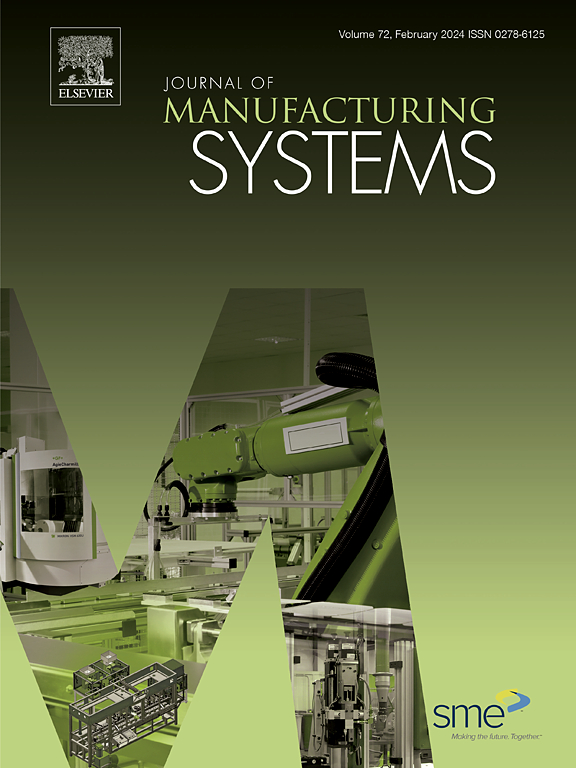Puzzle mode graph learning with pattern composition relationships reasoning for defect detection of printed products
IF 14.2
1区 工程技术
Q1 ENGINEERING, INDUSTRIAL
引用次数: 0
Abstract
Patterns are designs composed of specific elements and are widely present in various printed products, representing particular design intentions. However, due to printing errors, pattern defects are extremely common in these products, significantly impacting their visual quality and market price, especially in high-value customized products like luxury apparel, premium wallpapers and decorative tiles. Traditional detection methods struggle to provide effective judgments with conventional visual cues purely and frequently fall short due to the intricate nature of the pattern composition. To overcome this challenge, we propose a puzzle mode graph learning method capable of reasoning about pattern composition relationships. This novel detection framework simulates the logical reasoning ability of humans in assembling unordered puzzle pieces into a complete pattern, thus surpassing spatial structure limitations and enabling structural defect detection in patterns. Specifically, a parametric representation function is integrated into convolutional layers to enhance the segmentation accuracy of shape masks. Then, cross-graph semantic matching rules are developed to dynamically re-encode the adjacency matrix, enabling the construction of an attribute relationship graph that explicitly describes pattern attributes, including pattern elements, color sequences and shape positions. Moreover, the defective reasoning mechanism calculates puzzle-mode scores to decouple semantic relationships of defect features, inferring anomalous node and edge weights affecting the graph structure, thereby facilitating more precise judgments of pattern defects. Comparative experiments conducted on a real printed defect dataset validate this method. Results demonstrate its effectiveness and robustness in identifying complex pattern defects, providing essential support for appearance quality control in high-end industrial products.
基于图案组成关系推理的拼图模式图学习在印刷品缺陷检测中的应用
图案是由特定元素组成的图案,广泛存在于各种印刷产品中,代表着特定的设计意图。然而,由于印刷错误,图案缺陷在这些产品中非常普遍,严重影响了它们的视觉质量和市场价格,特别是在奢侈品服装,高级壁纸和装饰瓷砖等高价值定制产品中。由于图案组成的复杂性,传统的检测方法很难通过传统的视觉线索提供有效的判断。为了克服这一挑战,我们提出了一种能够推理模式组成关系的谜题模式图学习方法。这种新颖的检测框架模拟了人类将无序拼图拼装成完整图案的逻辑推理能力,从而超越了空间结构的限制,实现了图案结构缺陷的检测。具体而言,将参数表示函数集成到卷积层中,以提高形状掩码的分割精度。然后,开发了跨图语义匹配规则,对邻接矩阵进行动态重新编码,从而构建了一个属性关系图,该关系图明确地描述了模式属性,包括模式元素、颜色序列和形状位置。此外,缺陷推理机制通过计算谜题模式得分来解耦缺陷特征的语义关系,推断影响图结构的异常节点和边缘权重,从而更精确地判断模式缺陷。在实际印刷缺陷数据集上进行的对比实验验证了该方法的有效性。结果表明,该方法在识别复杂图案缺陷方面具有有效性和鲁棒性,为高端工业产品的外观质量控制提供了必要的支持。
本文章由计算机程序翻译,如有差异,请以英文原文为准。
求助全文
约1分钟内获得全文
求助全文
来源期刊

Journal of Manufacturing Systems
工程技术-工程:工业
CiteScore
23.30
自引率
13.20%
发文量
216
审稿时长
25 days
期刊介绍:
The Journal of Manufacturing Systems is dedicated to showcasing cutting-edge fundamental and applied research in manufacturing at the systems level. Encompassing products, equipment, people, information, control, and support functions, manufacturing systems play a pivotal role in the economical and competitive development, production, delivery, and total lifecycle of products, meeting market and societal needs.
With a commitment to publishing archival scholarly literature, the journal strives to advance the state of the art in manufacturing systems and foster innovation in crafting efficient, robust, and sustainable manufacturing systems. The focus extends from equipment-level considerations to the broader scope of the extended enterprise. The Journal welcomes research addressing challenges across various scales, including nano, micro, and macro-scale manufacturing, and spanning diverse sectors such as aerospace, automotive, energy, and medical device manufacturing.
 求助内容:
求助内容: 应助结果提醒方式:
应助结果提醒方式:


